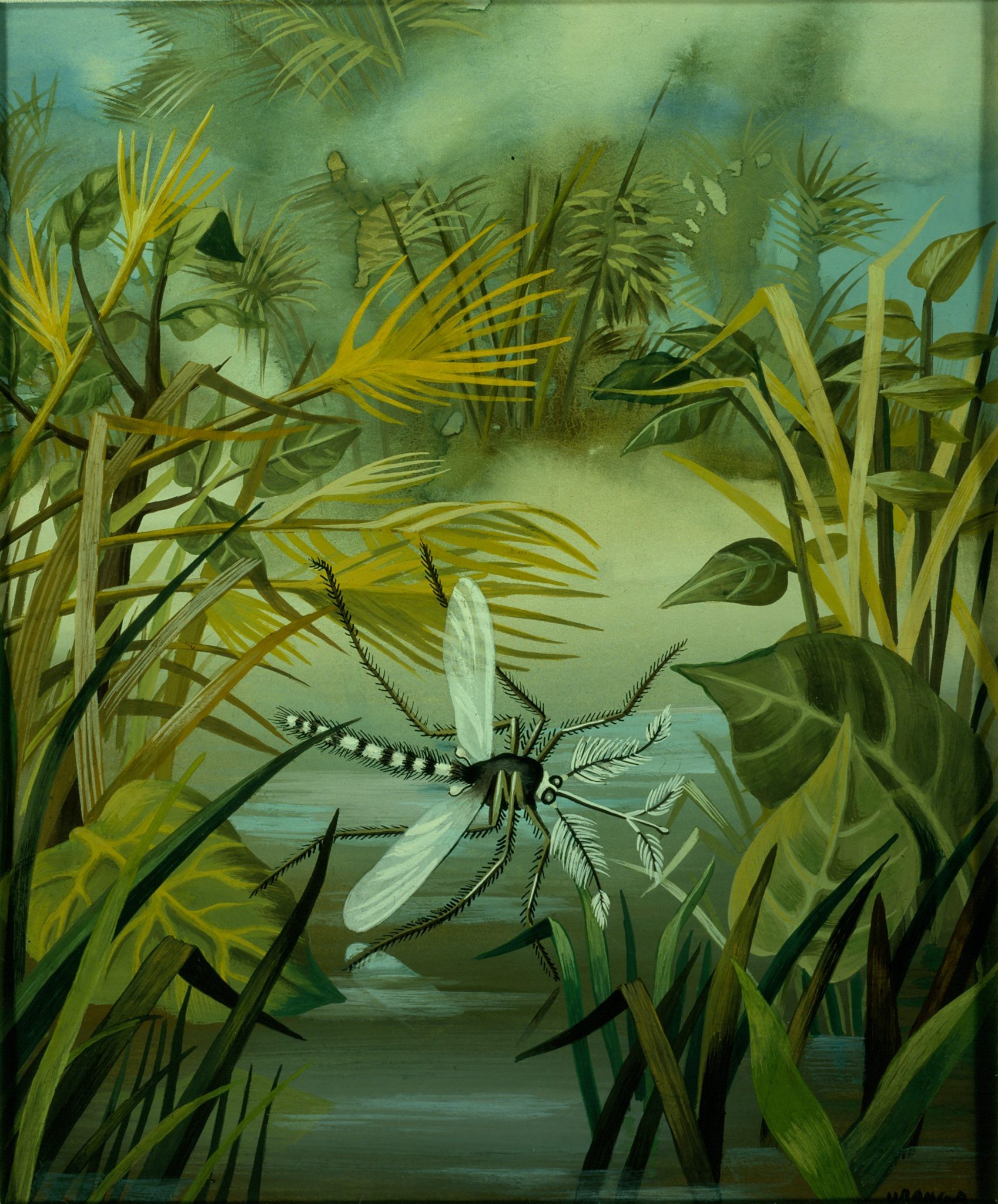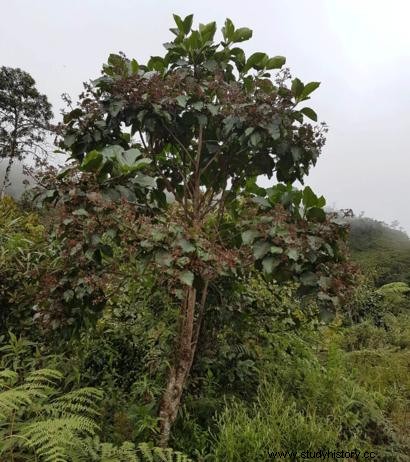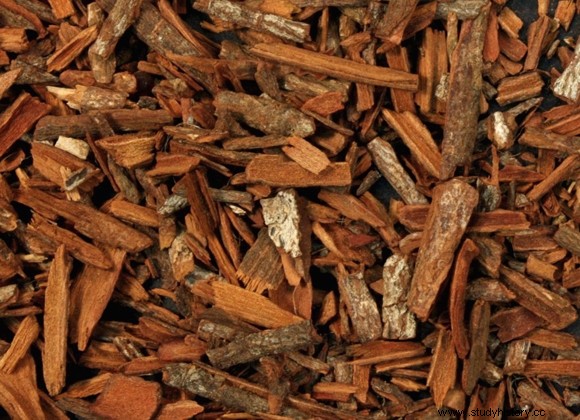In the article published on the 19th, on the history of the gin and tonic, he ended with a question:Do you know why quinine overdose poisoning is called cinchonism ? Well, for the Countess of Chinchón. This is the story.
A story that begins with the movie Jurassic Park, directed by Steven Spielberg in 1993 and based on the book of the same name by Michael Crichton, which recounts how a billionaire philanthropist creates a living dinosaur park thanks to the work of highly original and creative geneticists who managed to clone them from the DNA of a mosquito prehistoric preserved in amber. More or less, so as not to expand too much. And before going into flour, I am going to recommend Dinópolis, in Teruel, a dinosaur theme park, with much less fantasy than Spielberg's but more reality. And going back to Jurassic Park, if we ignore the cloning part and keep the mosquito preserved in amber, it will allow us to establish that malaria , that of the parasitic protozoan Plasmodium and the Anopheles mosquito , has existed for more than 20 million years.

Logically, I am not saying it, it is the result of the work of more than 20 years of marriage George and Roberta Poinar , an entomologist and an electron microscopist, who discovered that prehistoric insects trapped and preserved in amber had some intact cells, including parts of their DNA. From a piece of amber from the Dominican Republic, between 15 and 20 million years old, they obtained the oldest proof of the presence of Plasmodium in the DNA of a mosquito that was trapped in fossilized amber. A drop of resin flows from a tree, catches a specimen, and when it hardens it preserves it in almost perfect condition. And it can even be a little embarrassing, because the trapped critters die so quickly that they are portrayed for posterity as they were at that precise moment. Imagine that the bug and the bug are there, doing their thing, hidden from prying eyes and they have the bad luck of being caught by the damn drop. Well, you already have it wrapped up, because you know that, in addition, the amber in question is going to go viral and the whole world is going to know your attitude, let's say, unseemly.
We take an evolutionary leap to reach our hunter-gatherer ancestors, where their diet consisted of a varied diet from the meat of animals they hunted or from the remains left by predators, what they obtained from fishing and everything else provided by their environment:berries, fruits, roots, herbs, tubers... As much as sustainable consumption is fashionable, they were the inventors, since they consumed seasonal and local products. They moved in small groups as nature dictated, adjusting to the flora and fauna of each place, and normally settling in basic and temporary shelters. As their brains evolved and hunting tools developed, it allowed them to access larger game - they even dared with mammoths. Likewise, this evolution allowed them to develop a more complex knowledge of the life of edible plants and their growth cycles, achieving a more efficient use of each place. Having more resources made it possible to maintain more members and, logically, increase the population. And here, more or less, comes the so-called Neolithic Revolution, when the first radical transformation of the way of life of humanity takes place, going from being nomadic to sedentary and from having a gathering economy (hunting, fishing and gathering) to a producer ( Agriculture and Livestock). The development of agriculture allowed the creation of the first stable population centers and the construction of structures that allowed community life. The need for water, both for the population and for crops and animals, made it essential that the settlements were around it, the ideal place for the proliferation of mosquitoes. In fact, the word malaria comes from the Latin palus (“lagoon”, “pond”, “swamp”) and malaria from Italian mal’aria , which is the contraction of mala aria, that is, "bad air", because it was thought that the disease was caused by bad air from stagnant waters. So, proximity to mosquito breeding sites and overcrowding made malaria a plague. So it could be concluded that the spread of malaria began with agriculture. In addition, very few communities were spared, because mosquitoes are found both at sea level and up to altitudes of 3,000 meters.

Malaria (1947) – Remedios Varo
How to deal with malaria?
Well, ruling out remedies that we could include under the heading "kill flies with cannon fire", which there were, and many, we are left with quinine , a chemical compound that is extracted from the bark of the cinchona tree (Cinchona officinalis , for scientists), species native to the South American Andes, mainly in Bolivia, Peru, Colombia, Ecuador and Venezuela. The cinchona bark was already used by pre-Columbian cultures for episodes of fever, and the link of this natural remedy against malaria begins with a legend, that of Pedro Leyva , an indigenous person from Loja (today, Ecuador). It is said that Pedro Leyva was ill with malaria and seized by the fever he wandered through the forest until he fell face down on the edge of a pond. Drenched in sweat, he brushed aside the leaves and branches and drank water that, by the way, he found quite bitter. Miraculously, the fever began to subside. The branches and leaves that he separated to drink, were from the trees that surrounded the pond, which were none other than the cinchona tree, which, precisely, gave it that bitter touch. Be it one way or another, Pedro Leyva, according to some sources a kind of healer and according to others a local cacique, began to use the infusion of the bark to treat malaria patients due to its properties to combat fever (in those parts known as “tertiary ” or “hot flashes ”). The truth is that I am inclined to think that he was a healer because, before knowing what made the water miraculous, he experimented with other malaria patients by giving them water from different places until he found out that the key was in the cinchona tree. I do not see a local cacique involved in a scientific analysis to establish that the active ingredient was in that tree and, specifically, in the branches, bark and root.

In 1630, with the Jesuits there dancing and evangelizing, Father Juan López de Cañizares he fell ill with malaria and our local doctor cured him by giving him a concoction made from the powder of cinchona bark. For better or for worse -although it should be said for better or for worse-, western medicine came into contact with the knowledge of the indigenous people. In 1635, the Jesuit Bernabé Cobo published his “History of the New World ”, And there he wrote:
In the limits of the city of Loja, diocese of Quito, there is a certain breed of large trees that have bark like cinnamon, a little thicker, and very bitter, which, ground into powder, is given to those who have fevers. and with only this remedy they are removed.
The jump to Lima will take place when Francisca Enríquez de Rivera , wife of the viceroy of Peru and countess of Chinchón, she contracted malaria and the Jesuits sent her the magic powder. Logically, she healed. The viceroy saw fit to distribute it among the population and, in Lima, the powders from the bark of the cinchona tree were known as “powders of the countess ”. And there is even more, Mrs. Francisca is also responsible for her scientific name. Charles Linnaeus , the Swedish naturalist and botanist, was the creator of the classification of living things. In 1731 he developed a binomial nomenclature system based on the use of a first term, with its initial letter written in capital letters, indicative of the genus, and a second part, corresponding to the specific name of the species described, written in lowercase letters. And it was he who, in homage to the Countess of Chinchón, gave the quinine the name of Cinchona and the last name of officinalis . For this reason, quinine overdose intoxication is called cinchonism

Okay, I know something doesn't add up, because the noblewoman is the Countess of Chinchón and the scientific name is Cinchona, but she has her explanation. Well, two. The first, which was originally called Cinchona and, due to some transcription error that was never corrected, remained in Cinchona; and, the second, that Linnaeus italianized it, since it is written “ci” but pronounced “chi”. And what does Italian have to do with it? Well, perhaps the key lies in what our head Jesuit wrote years later...
These powders are already so well known and esteemed, not only in all the Indies, but in Europe, that they promptly send them to request from Rome.
The Jesuits ensured that, from Loja, the first destination of the powders across the pond was Rome. You have to keep the boss happy. The fact is that the success of this medicine was spread by the Jesuits in the 17th century, which is why in those times in Europe it was known as the “Jesuit bark ”.

Although all this history is riddled with myths and legends, the reality is that the demand for the bitter quinine, which was effectively effective against malaria, grew and grew, as well as its price and, consequently, the business around the tree of the machine from which the indigenous people were irremediably excluded. In fact, if you have noticed, none of the names by which it was known refers to its origin or the role of Pedro Leyva who, without imagining it, became a benefactor of humanity. And the truth is that the cinchona tree almost died of success. Given the importance of the bark as the only cure for malaria at that time, it began to be felled indiscriminately and the Jesuits, through Spain, sent it to Europe. Already in the eighteenth century, the Frenchman Charles-Marie de La Condamine and, later, the Spanish José Celestino Mutis , at the head of the Royal Botanical Expedition of the New Kingdom of Granada, traveled to South America and prepared the first scientific reports of that miraculous product. The rest of the European powers, especially England and the Netherlands, were fighting for access and control over this precious resource. So, they mounted their own expeditions, dressed as scientists, to claim their share of the pie. Hordes of merchants roamed the Andean forests in search of cinchona and, seeing that there was little to scratch, they changed tactics and instead of obtaining it directly from the source, they took the seeds to have their own plantations. At the end of the 19th century, the English had their own production in India and the Dutch on the island of Java (Indonesia). In fact, 90% of the world trade in bark and quinine, between 1890 and 1940 - when the Japanese took over Java and cut off the supply - came from the Dutch colonies in Indonesia. With quinine at its disposal, Europe was able to colonize malarial countries in Asia and Africa and build its empires.
And what happened to the cinchona forests in South America?
Since its discovery, it has been exported in large quantities abroad, but when the trees were cut down or their bark removed, others were not planted, so the known forests were depleted and forced to search for them in more hidden and difficult to access places. If we add to the overexploitation that agricultural clearing also reduced land in the humid forests -habitat of the cinchona tree-, we have that, to date, it is included in the list of wild flora species in a vulnerable situation. In Peru, for example, where the tree has been present on its coat of arms since 1825, representing the botanical diversity of the country, there are barely between 500 and 600 trees left.

